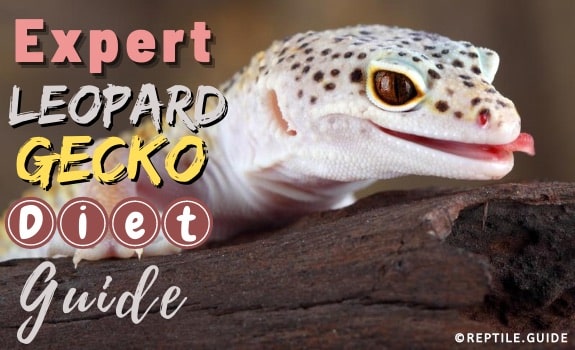Leopard geckos (opens in new tab) are small, insectivorous lizards native to the deserts of Afghanistan, Pakistan, India, and Iran.
Their cute appearance, small size, and easy husbandry requirements make them a popular pet for reptile keepers.
Unlike many other lizards, which may require varied diets from different food groups and unique food preparation techniques, the menu of a pet leopard gecko is relatively straightforward: live insects and vitamins.
In fact, the easiest mistake to make when caring for and feeding your leopard gecko is to overfeed it. These little guys usually have voracious appetites and will happily gorge themselves with whatever food is available.
However, just like in humans and any other animal species, obesity is a severe health problem and can drastically shorten your pet’s lifespan.
Reduced appetite is another dietary problem that leopard gecko owners may face.
Rest assured, food strikes are prevalent in just about every reptile species and, thanks to their slow metabolisms, usually only require a little bit of time and patience.
Accompanied by an excellent habitat with the proper temperature, humidity, hides, and exercise opportunities, a proper diet will ensure that your pet gecko lives a long, healthy, and happy life.
In This Article
What do Leopard Geckos Eat?
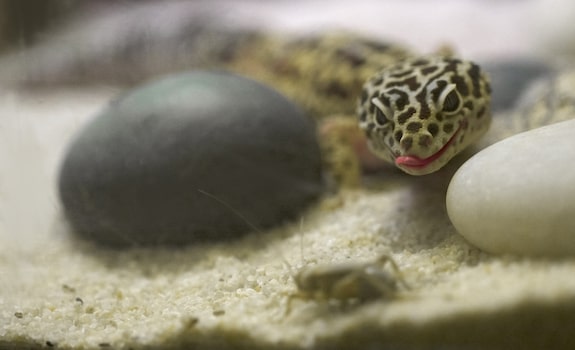
Leopard geckos are strictly insectivores. This means that they eat bugs.
You don’t need to worry about fruit, meat, vegetables, or grain – just ditch that whole food pyramid idea. Your pet only has eyes for delicacies that are creepy and crawly!
However, just because your pet “only” eats bugs does not mean that his or her diet should be boring! These days, there is a vast array of feeder insects available.
Feeding a variety of different insects is an essential form of enrichment for your pet. It also increases the likelihood that your leopard gecko is getting all its required vitamins and micronutrients.
Leopard Gecko Diet: Supplies
Below, you’ll find the 3 must-haves you’ll need to feed your leopard gecko and discover why each of them is important.
Water Bowl
Fresh, clean water should always be available to your pet gecko in a spill-proof, shallow bowl to prevent drowning.
Tap water is also acceptable; it contains many trace minerals, which may be beneficial for your pet.
Calcium Bowl
Some leopard gecko owners choose to leave calcium powder in a dish for their leopard gecko. The dish is always available. Leopard geckos have a high calcium requirement.
This situation allows your pet to self-regulate its calcium intake and lick the supplement whenever the body signals a need for it.
However, there is a small risk of calcium overdose, so some keepers choose to dust all feeder insects with calcium, instead.
Also, please note that adolescent leopard geckos require MORE calcium than adults. So, you may only find this beneficial if your pet is still a juvenile.
If you choose to make calcium available in a bowl 24/7, only use calcium powder WITHOUT vitamin D3 to reduce the risk of a vitamin D3 overdose.
Food Bowl (& alternatives)
Most leopard gecko owners put their pet’s feeder insects in a deep bowl with smooth sides.
This is especially helpful in the instance of feeding grubs and some roaches, as they are unable to escape from these bowls.
However, it’s important to note that crickets and some types of roaches and beetles will easily escape any kind of feeding dish.
If your leopard gecko seems hesitant to eat from a bowl, you can try fasting him or her for a few days and using a clear container with extra-wriggly insects to stimulate its hunting and feeding response.
Exceptionally spoiled leopard geckos can be fed from a pair of soft-tipped feeding tongs or even your fingers! This may help you and your leopard gecko form a bond.
This can be great for enriching your pet’s life and encouraging exercise but could also lead to uneaten feeder insects hiding in the enclosure.
As such, you’ll need to regularly inspect the enclosure to ensure no uneaten bugs remain as they can pester and stress out your pet.
What Insects to Feed a Leopard Gecko
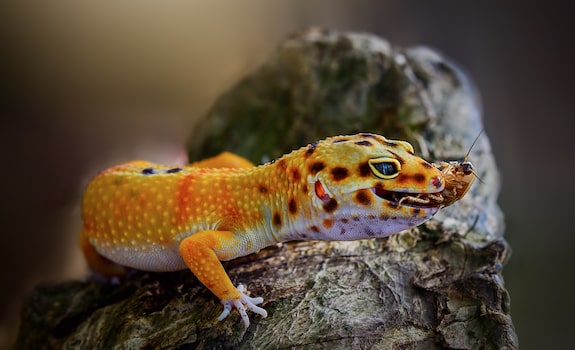
These insects have ideal or close to ideal protein and fat content, and they can be the staple of your pet’s diet.
As a rule of thumb, don’t feed your leopard gecko any insects that are bigger than the space between their eyes.
You could offer canned or freeze-dried insects, but they aren’t as nutritional as fresh, live insects, and most leopard geckos are uninterested in prey that doesn’t move.
Regularly feed your leopard gecko any combination (the more varied, the better!) of the following:
- Mealworms
- Hornworms
- Crickets
- Roaches
- Beetles
- Sow Bugs
- Silkworms
- Phoenix Worms
Treat Insects
Treat insects have a high amount of fat. Limit these treats to once or twice a week, or more often if you’re trying to help your leopard gecko gain weight.
Indulge your leopard gecko with any of the following on occasion:
- Superworms
- Waxworms
- Butterworms
🤓 Expert Tip: Although it is never a good idea to let any reptile you own eat insects you’ve caught outside due to the risk of ingesting poison0us pesticides or parasites, you’ll want to especially avoid feeding them any insect that glows. Insects like this, such as lightening bugs, contain a chemical that is highly toxic and can be lethal if ingested by your gecko.
Leopard Gecko Vitamins
No captive diet can replicate the nutritional value of the variety of invertebrate, vertebrate, and possibly even occasional plant species that a leopard gecko would ingest in the wild.
This is why supplementing with vitamins is SO important!
You see, commercial vitamin supplements help to bridge this dietary gap. Simply put the feeder insects in a plastic bag with the supplement powder, give it a little shake, and then offer the coated feeder insects to your pet gecko.
Here’s how often to supply each vitamin type:
- Calcium Powder WITHOUT Vitamin D3: Always available in a dish in your leopard gecko’s enclosure, or dusted on insects for EVERY feeding
- Calcium Powder WITH Vitamin D3: 2-3 times per week. This isn’t required if you use a UVB bulb in your leopard gecko’s enclosure.
- Carnivorous Reptile Multivitamin: Every week or every other week.
Leopard Gecko Feeder Insect Information
Now that you understand the importance of vitamins and what insects you can give your leopard gecko, let’s briefly discuss a couple topics in relation to feeders.
In the following section, you’ll get a bird’s eye view of the nutritional breakdown of feeders, as well as how to care for them, and why you should consider buying them in bulk.
Leopard Gecko Feeder Insect Nutritional Breakdown
Reptiles need an equal amount of calcium to process phosphorus. The ideal calcium to phosphorus (AKA Ca:P) ratio is 2:1.
Most insects have higher phosphorus than calcium, which is why we coat them in calcium powder.
When it comes to fat and protein content, opt for higher protein and lower fat for overweight or healthy adult leopard geckos.
Younger animals and animals that are used for breeding may benefit from insects with higher fat content.
With all of that said, here’s some in-depth information about the nutritional content of common feeder bugs…
| Feeder | Protein % | Fat % | Ca:P Ratio | Gut Loading |
|---|---|---|---|---|
| Crickets | 19% | 5% | 1:9 | Commercial high calcium cricket gut load, vegetables, fruits, dog or cat food |
| Mealworms | 19% | 9% | 1:7 | Greens, carrots, squashes |
| Superworms | 19% | 18% | 1:18 | Greens, carrots, squashes |
| Silkworms | 13% | 2% | 1:2.4 | N/A |
| Pheonix Worms | 18% | 10% | 1.5:1 | N/A |
| Roaches | ~20% | ~8% | 1:3 | Fresh fruits and vegetables |
| Hornworms | 9% | 3% | 1:3 | Hornworm media included in container |
| Waxworms | 15% | 22% | 1:7 | N/A |
| Butterworms | 16% | 17% | 1:18 | N/A |
Above you can see how these 9 feeders stack up against one another in terms of protein, fat, Ca:P ratio, and how to properly gut-load them (if applicable).
It’s important to know all of this information because, depending on your leo’s age, weight, and overall health, you may find a preference for one feeder over another.
For instance, if you have a seriously overweight leopard gecko, then you’re probably going to want to stick with feeding them crickets, silkworms, or hornworms until you get their weight under control.
Additionally, knowing the calcium and fat content can also be helpful because it will allow you to feed a sick or underweight leopard gecko.
How to Care for Leopard Gecko Feeders
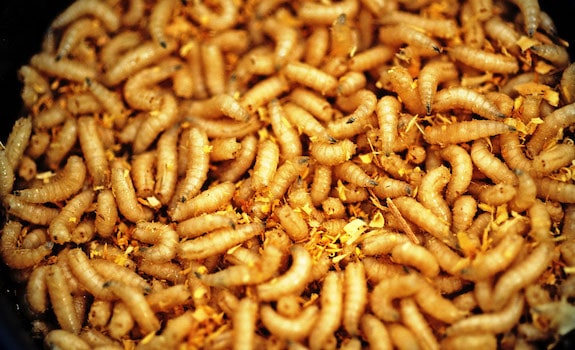
Below you’ll find easy-to-follow instructions on how to care for the 9 most common feeder insects your leopard gecko can enjoy.
By properly caring for these insects, you’ll be able to keep them healthy and living longer, which in turn will be more cost effective for you and beneficial to your pet.
Crickets
Keep in a secure, ventilated container with a lid and cardboard egg crates at room temperature for eight to ten weeks.
Mealworms
Keep in an open-top container without the lid, in wheat bran or oat bedding, in the fridge for up to two weeks.
Superworms
Keep in an open-top container without the lid, in wheat bran or oat bedding, at room temperature for up to a year.
Silkworms
Keep in the original container at room temperature for up to two weeks. Keep their food moist.
Phoenix Worms
Keep the original container in a cool room (50-70°) or the door of your fridge for up to three weeks.
Roaches
Keep in a smooth-sided container with cardboard egg crates at room temperature for up to three months.
Hornworms
Keep in the original cup, upside down, at room temperature for three to seven days.
Waxworms
Keep them in the original container at room temperature or the door of your fridge for up to one month.
Butterworms
Keep them in the original container in the door of your fridge for up to four months
Benefits of Buying Leopard Gecko Feeder Insects in Bulk
Since leopard geckos usually need to eat live insects, you should at least consider purchasing the bugs in bulk and caring for them until you feed them to your leopard gecko.
In fact, doing so will give you 2 distinct benefits…
Benefit #1: It’s Convenient
Baby leopard geckos need to eat EVERY day, and even adult leopard geckos need to eat several times a week.
Do you really want to go to the pet store that often?
Depending on the insect species, you can care for them and keep them alive for up to several months before you feed them to your leo.
Benefit #2: It Allows for Gut-loading
The phrase “you are what you eat” resonates here. A super worm that has recently consumed apples, carrots, and sweet potato will contain more vitamins and nutrients than a super worm that has only eaten oats its whole life.
Even though your leopard gecko can’t digest plant matter, they can benefit from the healthy properties of fresh foods by having their feeder insects do the plant digestion!
The optimal period for gut-loading insects is 12-48 hours before you feed them to your leopard gecko.
🤓 Expert Tip: Not 100% sure you’re down with the whole insect thing? Well, then why not consider adopting one of many strictly vegetarian reptiles instead? This way, you’ll never have to even fuss with insects dead or alive!
Baby Leopard Gecko Diet
All leopard geckos eat insects and ONLY insects. However, baby leopard geckos will have slightly different needs than that of adults.
Compared to adult leopard geckos, juvenile leopard geckos need:
- More calcium
- Smaller insects
- More frequent meals
Baby Leopard Gecko Diet Feeding Schedule
Not sure how often to feed your baby or how much to give them? No worries! Just consult the breakdown below…
Age: 0-6 Months
Frequency: Daily
Insect Size: ⅜”
Amount: As much as they can eat in fifteen minutes
Age: 6-12 Months
Frequency: Every other day
Insect Size: ¼”
Amount: As much as they can eat in fifteen minutes
Adult Leopard Gecko Diet
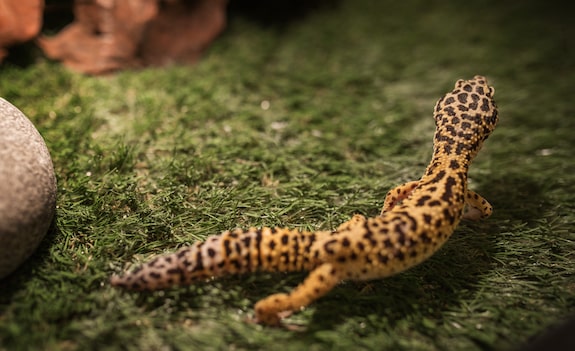
After your leopard gecko reaches twelve months of age, your BIGGEST concern will be preventing it from becoming overweight or obese.
You can still offer calcium freely in a dish, but you may find that you’ll need to refill it less often.
To avoid the risk of a calcium overdose, some keepers remove the calcium dish once their leopard gecko reaches adulthood and opt to dust the feeder insects, instead.
Some particularly gluttonous leopard geckos will feast on calcium powder out of boredom or just to fill their tummy.
Adult Leopard Gecko Feeding Schedule
Age: 12+ Months
Frequency: Every 2-3 days
Insect Size: ½”-¾”
Amount: Two insects for every inch of body length
Monitor your leopard gecko’s weight closely with a kitchen or postal scale that weighs in grams.
This is important to make sure that your leopard gecko isn’t gaining too much weight AND to make sure that it isn’t losing too much weight if it goes on a hunger strike.
A healthy adult leopard gecko will have a tail that, at the thickest point, is as wide as its neck. If your leopard gecko’s tail is thicker than its neck or has bubbles of fat and tissue behind its arms, it is overweight.
If you find your leopard gecko to be overweight, you’ll need to cut back on the number of insects offered and the feeding frequency to help it lose weight.
Taking your pet out of its enclosure for some exercise and enrichment can also go a long way.
What NOT to feed a Leopard Gecko
Leopard geckos don’t have the anatomy required to digest fruits, vegetables, and grains. They may show interest in these kinds of foods, but they likely offer NO nutritional value to your pet.
Meat is generally viewed as unhealthy for leopard geckos due to low calcium and high fat levels. Raw meat can carry dangerous bacteria, and cooking meat destroys its nutritional value.
Pinkie mice may be offered to sick, underweight, or breeding leopard geckos as a source of additional fat and protein. This should be a temporary dietary addition only.
You may choose to offer insects and invertebrates you find outside in your yard, but keep in mind that these insects are likely to be carrying parasites and possibly even insecticides and other outdoor poisons.
The general rule of thumb is that if it’s not a feeder insect or a vitamin supplement, don’t feed it to your leopard gecko.
Help! My Leopard Gecko Isn’t Eating
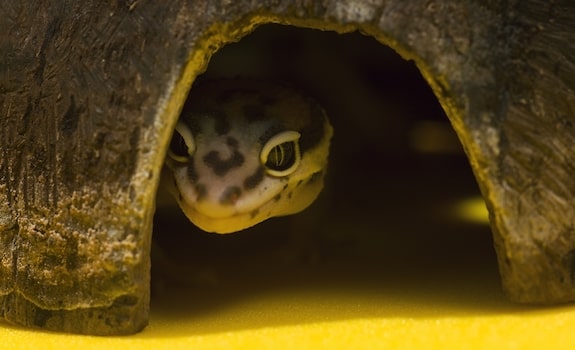
The first step to resolving this problem is to relax…
Cold-blooded reptiles have slow digestive systems; they’ve evolved to withstand days, weeks, and in some cases, months without eating when the conditions aren’t ideal.
7 Reasons Your Leopard Gecko May Be on a Hunger Strike
Rest assured, if your leopard gecko is not eating… there’s a reason! Consider the following 7 reasons below.
Reason #1: Stress
This is especially common for newly acquired leopard geckos. This situation simply requires patience.
New leopard geckos can go over a week without accepting food.
Avoid handling your new pet for the first week, or until it’s eating consistently. Even after the first week, some stressed-out geckos may be finicky eaters for several more weeks.
Any changes, even little ones, to their environment or enclosure can cause this cycle to repeat itself.
Reason #2: Temperature
Leopard geckos are ectothermic, meaning they depend on the environmental temperature to heat their body. Without heat, they can’t digest their food.
If they can’t digest their food, they aren’t going to want to eat.
Ensure that your leopard gecko has access to a basking spot or hide that consistently measures 87-94°F.
Reason #3: Shedding
Many leopard geckos will refuse food for a few days before and a few days after they shed.
Also, they usually eat their shed skin. Weird, I know. But remember, they’re little gluttons.
Reason #4: Mating Season
The breeding season for leopard geckos usually starts around January and lasts up until June or July.
Females that are ovulating may not have an appetite, but egg production takes a lot of resources, and they’ll need extra food and supplements once their appetite picks up.
Even if your female leopard gecko wasn’t introduced to a male for breeding, she might produce infertile eggs. She may even eat them.
Males can also become so distracted with trying to find a partner that they lose interest in food during the breeding season, too.
⭐️ Fun Fact: Did you know, female leopard geckos lay just 1 to 2 eggs per clutch? Sounds pretty manageable considering other reptiles, such as the bearded dragon can lay a whopping 20 (and in some instances even more!) eggs per clutch!
Reason #5: Brumation
Even though our pet leopard geckos live inside controlled environments, they’ve retained many of their instincts, and their internal biological clock is still ticking.
Minor temperature and lighting changes in the late Fall and early Winter may cause your leopard gecko to enter a state of brumation.
They’ll become less active and stop eating, but you may still see them move around the enclosure and drink water.
Reason #6: Disease
If you’ve ruled out the above possible scenarios and your leopard gecko seems sickly, an infection or parasites may be the cause.
In this case, it’s best to get your pet to an experienced reptile veterinarian as quickly as possible.
Reason #7: Gastrointestinal Blockage
If you keep your leopard gecko on loose substrate, a gastrointestinal blockage is a very real possibility.
This is why it’s important be well educated on ALL your leopard gecko substrate options.
Symptoms include:
- Food refusal
- Regurgitation
- No bowel movements
This is an EMERGENCY and can be fatal if left untreated.
If you suspect a gastrointestinal blockage, take your leopard gecko to an experienced reptile veterinarian as quickly as possible.
Wrapping Up Leopard Gecko Diet & Feeding Guide
Congratulations on finishing this crash course in leopard gecko diet and nutrition! You’re now ready to serve your leopard gecko a long life of health and happiness thanks to a proper diet!
As a final takeaway, remember to ALWAYS monitor your leopard gecko’s weight closely, using a scale that weighs in grams.
Drastic weight gain and extreme weight loss are equally detrimental to your pet’s health, but now you know how you can resolve either issue by paying attention to feeder insect nutritional content, feeding frequency, environmental conditions, and providing veterinary care as needed.
Remember the basics: bugs, water, and vitamins.
Variety of insect types, and gut-loading the insects prior to offering them to your leopard gecko will ensure a nutritionally complete diet. Pair that perfect diet with ideal habitat, and you and your little leo can enjoy many happy years together.
